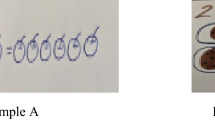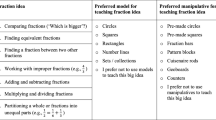Abstract
This study is an investigation of elementary preservice teachers’ (PSTs’) exploration of model breaking points in fractions. Eighty-three PSTs at two universities in the Midwestern and Southwestern regions of the USA were asked to explore the area model of fraction addition through a series of tasks and explain their reasoning in determining its affordances and constraints. The PSTs presented their critical mathematical ideas on modeling fraction addition and area models’ breaking points when used to add two fractions, as well as suggestions for alternative models to overcome model breaking points. An inductive content analysis showed that most PSTs represented fraction addition well with simple fractions but had difficulty representing fraction addition with improper fractions or fractions with unlike and relatively large denominators and tended to use algorithm-based thinking. Also, the area models drawn by several PSTs revealed various misconceptions, suggesting the impact of their content knowledge on their understanding of area models. Based on the findings from this study, we provide some implications for teacher educators.




Similar content being viewed by others
References
Ball, D. L. (1992). Magical hopes: Manipulatives and the reform of math education. American Educator, 16(2), 14–18.
Ball, D. L., Thames, M. H., & Phelps, G. (2008). Content knowledge for teaching: What makes it special? Journal of Teacher Education, 59(5), 389–407.
Baumert, J., Kunter, M., Blum, W., Brunner, M., Voss, T., Jordan, A. . . . Tsai, Y.-M. (2010). Teachers’ mathematical knowledge, cognitive action in the classroom, and student progress. American Educational Research Journal, 47, 133–180.
Cai, J. (2005). U.S. and Chinese teachers’ constructing, knowing, and evaluating representations to teach mathematics. Mathematical Thinking and Learning, 7(2), 135–1169.
Cai, J. (2006). U.S. and Chinese teachers’ conceptions and constructions of representations: A case of teaching ratio concept. International Journal of Science and Mathematics Education, 4, 145–186.
Cramer, K., & Henry, A. (2002). Using manipulative models to build number sense for addition of fractions. In B. Litwiller & G. Bright (Eds.), Making sense of fractions, ratios, and proportions (pp. 41–48). Reston, VA: National Council of Teachers of Mathematics.
Cramer, K., Wyberg, T., & Leavitt, S. (2008). The role of representations in fraction addition and subtraction. Mathematics Teaching in the Middle School, 13(8), 490–496.
DeCuir-Gunby, J. T., Marshall, P. L., & McCulloch, A. W. (2011). Developing and using a codebook for the analysis of interview data: An example from a professional development research project. Field Methods, 23, 136–155.
Duval, R. (2006). A cognitive analysis of problems of comprehension in the learning of mathematics. Educational Studies in Mathematics, 61, 103–131.
Empson, S. B. (1999). Equal sharing and shared meaning: The development of fraction concepts in a first-grade classroom. Cognition and Instruction, 17(3), 283–342.
Graneheim, U. H., & Lundman, B. (2004). Qualitative content analysis in nursing research: Concepts, procedures, and measures to achieve trustworthiness. Nurse Education Today, 24, 105–112.
Grbich, C. (2007). Qualitative data analysis: An introduction. Thousand Oaks, CA: Sage.
Greeno, J. G., & Hall, R. P. (1997). Practicing representation: Learning with and about representational forms. Phi Delta Kappan, 78, 361–367.
Hackenberg, A. J., & Lee, M. Y. (2015). Relationships between students’ fractional knowledge and equation writing. Journal for Research in Mathematics Education, 46(2), 196–243.
Hill, H. C., Rowan, B., & Ball, D. L. (2005). Effects of teachers’ mathematical knowledge for teaching on student achievement. American Educational Research Journal, 42, 371–406.
Hill, H. C., Ball, D. L., & Schilling, S. G. (2008). Unpacking pedagogical content knowledge: Conceptualizing and measuring teachers’ topic specific knowledge of students. Journal for Research in Mathematics Education, 39(4), 372–400.
Hurrell, D. P. (2013). What teachers need to know to teach mathematics: An argument for a reconceptualised model. Australian Journal of Teacher Education, 38(11), 53–64.
Izsák, A. (2008). Mathematical knowledge for teaching fraction multiplication. Cognition and Instruction, 26(1), 95–143.
Kamii, C., Lewis, B. A., & Kirkland, L. (2001). Manipulatives: When are they useful. Journal of Mathematical Behavior, 20(1), 21–31.
Kleickmann, T., Richter, D., Kunter, M., Elsner, J., Besser, M., Krauss, S., & Baumert, J. (2013). Pedagogical content knowledge and content knowledge of mathematics teachers: The role of structural differences in teacher education. Journal of Teacher Education, 64, 90–106.
Kong, S. C. (2005). A cognitive tool for teaching the addition/subtraction of common fractions: A model of affordances. Computers & Education, 45(2), 245–265.
Lee, M. Y. (2017). Pre-service teachers’ flexibility with referent units in solving a fraction division problem. Educational Studies in Mathematics, 96(3), 327–348. https://doi.org/10.1007/s10649-017-9771-6.
Lee, M. Y., & Hackenberg, A. J. (2014). Relationships between fractional knowledge and algebraic reasoning: The case of Willa. International Journal of Science and Mathematics Education, 12(4), 975–1000. https://doi.org/10.1007/s10763-013-9442-8.
Lee, E., Brown, M. N., Luft, J. A., & Roehrig, G. H. (2007). Assessing beginning secondary science teachers’ PCK: Pilot year results. School Science and Mathematics, 107(2), 52–60.
Lee, S. J., Brown, R. E., & Orrill, C. H. (2011). Mathematics teachers’ reasoning about fractions and decimals using drawn representations. Mathematical Thinking and Learning, 13(3), 198–220.
McKendree, J., Small, C., & Stenning, K. (2002). The role of representation in teaching and learning critical thinking. Educational Review, 54, 57–67.
Morris, A. K., Hiebert, J., & Spitzer, S. M. (2009). Mathematical knowledge for teaching in planning and evaluating instruction: What can preservice teachers learn? Journal for Research in Mathematics Education, 40(5), 491–529.
National Council of Teachers of Mathematics. (2014). Principles to actions: Ensuring mathematical success for all. Reston, VA: Author.
National Governors Association Center for Best Practices & Council of Chief State School Officers. (2010). Common Core State Standards for Mathematics. Washington, DC: NGA & CCSSO.
Shulman, L. S. (1986). Those who understand: Knowledge growth in teaching. Educational Researcher, 15(2), 4–14.
van de Walle, J., Karp, K. S., & Bam-Williams, J. M. (2013). Elementary and middle school mathematics: Teaching developmentally (8th ed.). Upper Saddle River, NJ: Pearson.
Van de Walle, J. A., & Lovin, L. H. (2006). Teaching student-centered mathematics: Grades 3–5. Boston, MA: Allyn & Bacon.
van den Heuvel-Panhuizen, M. (2003). The didactical use of models in realistic mathematics education: An example from a longitudinal trajectory on percentage. Educational Studies in Mathematics, 54(1), 9–35.
Vig, R., Murray, E., & Star, J. R. (2014). Model breaking points conceptualized. Educational Psychology Review, 26, 73–90.
Woleck, K. R. (2001). Listen to their pictures: An investigation of children’s mathematical drawings. In A. A. Cuoco & F. R. Curcio (Eds.), The roles of representation in school mathematics: 2001 yearbook (pp. 215–227). Reston, VA: National Council of Teachers of Mathematics.
Zazkis, R., & Gadowsky, K. (2001). Attending to transparent features of opaque representations of natural numbers. In A. A. Cuoco & F. R. Curcio (Eds.), The roles of representation in school mathematics: 2001 yearbook (pp. 44–52). Reston, VA: National Council of Teachers of Mathematics.
Zhang, J. (1997). The nature of external representations in problem solving. Cognitive Science, 21(2), 179–217.
Author information
Authors and Affiliations
Corresponding author
Rights and permissions
About this article
Cite this article
Lee, JE., Lee, M.Y. Preservice Teachers’ Exploration of Model Breaking Points. Int J of Sci and Math Educ 18, 549–565 (2020). https://doi.org/10.1007/s10763-019-09974-3
Received:
Accepted:
Published:
Issue Date:
DOI: https://doi.org/10.1007/s10763-019-09974-3




